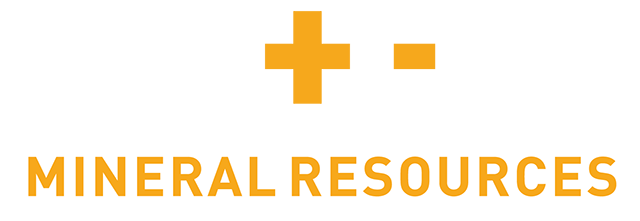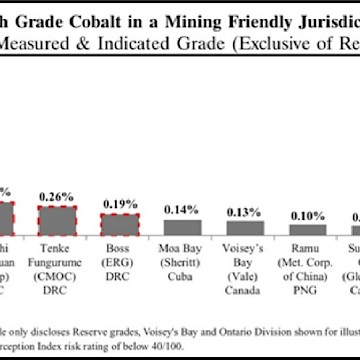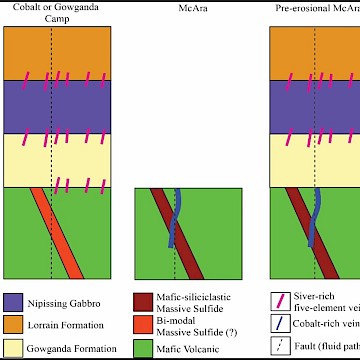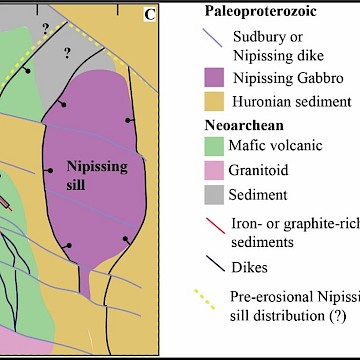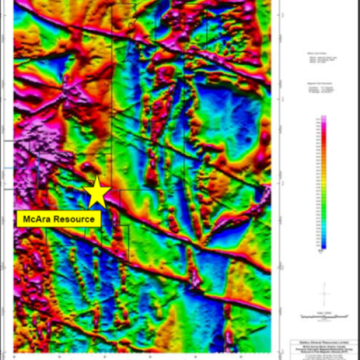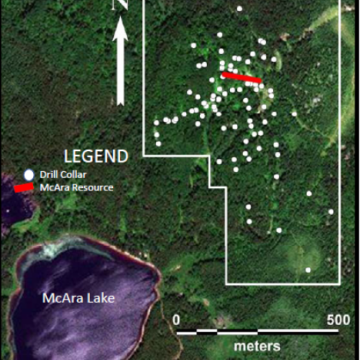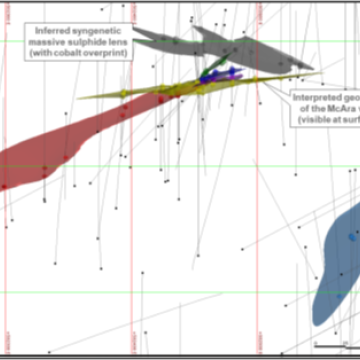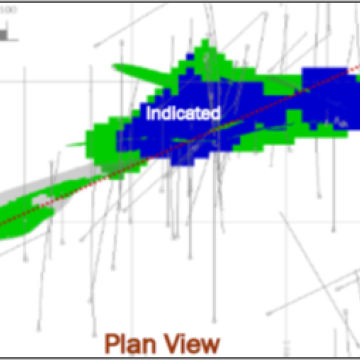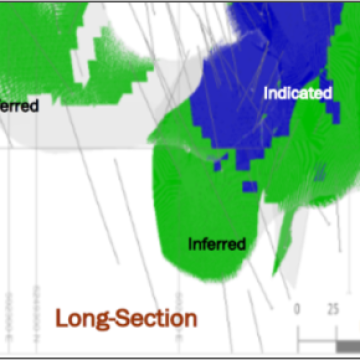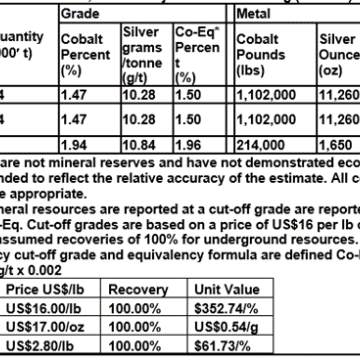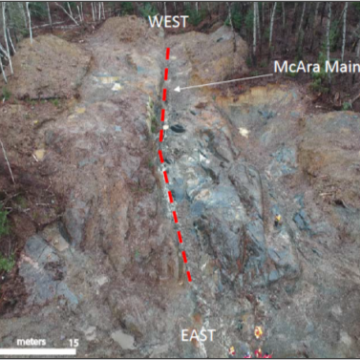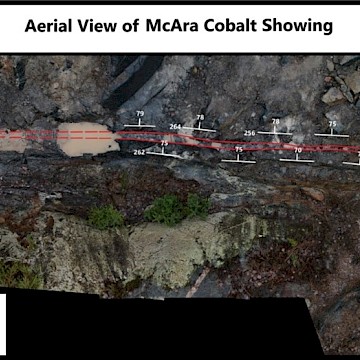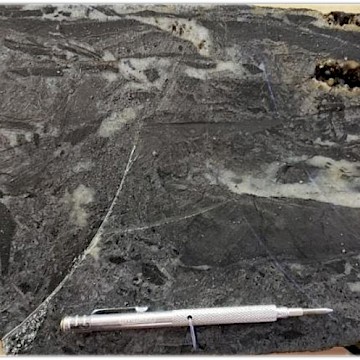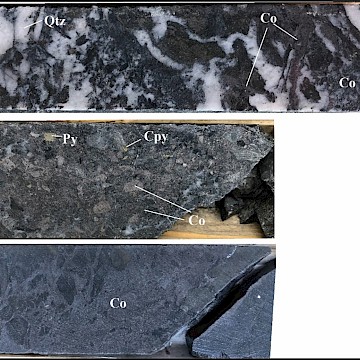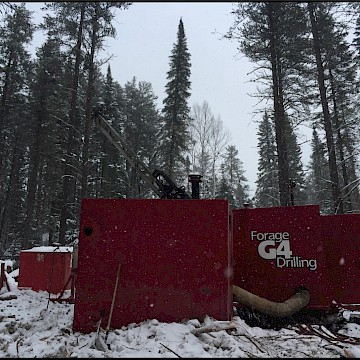McAra
Key Facts
Overview
McAra is the highest-grade primary cobalt deposit delineated in North America in the last 50 years. The McAra deposit hosts measured & indicated NI 43-101 resources of 1,124,000 lb of cobalt equivalent and inferred resource of 216,000 lb of cobalt equivalent. Mineral resources are reported at a cut-off grade at 0.75% cobalt equivalent, using a price of US$16 per Ib cobalt and US$17 per oz silver.
BMR's McAra deposit is a high-grade cobalt-rich deposit that is a variant of the traditional five-element deposit class that hosts significant high-grade silver-cobalt vein style mineralization at the Cobalt and Gowganda camps.
Geologically, the McAra deposit is unique among five-element deposits in the region as it is hosted within an Archean massive sulphide deposit and distal to Nipissing Diabase sills that hosted most of the historically mined ore. Thus, this previously overlooked, cobalt-rich setting as demonstrated at McAra remains a high priority for BMR's exploration program that is focused on identifying high-grade cobalt deposits to feed a central mill.
Initially, historical exploration drilling in the area was focused on drill testing airborne electromagnetic anomalies for copper-rich volcanogenic massive sulfide deposits which resulted in the discovery of cobalt-rich veins and breccias. One hundred and twenty-eight diamond drill holes (for a total of 19,919.78m) have been drilled by five companies at the McAra deposit since the late 1990s. Significant historic downhole core intercepts include:
- 0.57m at 13.36% cobalt and 82.5g/t silver from 79.2m (Drillhole WM-03)
- 0.46m at 10.03% cobalt and 41.2g/t silver from 23.82m (Drillhole WM-02)
- 0.46m at 9.44% cobalt and 30.3g/t silver from 27.26m (Drillhole WM-02)
- 0.31 m at 5.89% cobalt and 609.00g/t silver from 28.57m (Drillhole WM-10)
- 0.91m at 4.23% cobalt and 8.8g/t silver from 67.47m (Drillhole WM-03)
- 1.41m at 0.38% cobalt and 13.2g/t silver from 15.94m (Drillhole M06-20)
From 2017 - 2019, BMR completed 56 holes totaling 10,486.3m that systematically outlined the known cobalt-rich deposit to define a NI 43-101 compliant resource. Significant BMR downhole core intercepts include:
- 0.5m at 12.40% cobalt and 559.00g/t silver from 68.5m (Drillhole MCD17005)
- 1.75m at 11.14% cobalt and 102.89g/t silver over from 94.12m (Drillhole MCD19043)
- 1.74m at 8.63% cobalt and 92.64g/t silver from 152.26m (Drillhole MCD19047)
- 0.6 m at 5.97% cobalt and 33.20g/t silver from 163.4m (Drillhole MCD18028)
- 0.6m at 5.46% cobalt and 33.30g/t silver from 68.4m (Drillhole MCD19043)
- 3.2m at 5.26% cobalt and 24.2g/t silver over from 101.3m (Drillhole MCD17009)
- 1.1m at 1.91% cobalt and 22.76g/t silver from 100.4m (Drillhole MCD17012)
BMR's property-wide exploration activities have focused on the Cobalt Zone - McAra Project, Kite Lake Zone, SK2-EM Target and the SK4-EM Target. Initial target assessments included prospecting, geological mapping and rock grab sampling. The McAra claim block was covered by airborne geophysical surveys, several ground surveys focused on specific targets.
Metallurgical Testwork is ongoing and additional drilling is planned.
Historical Background
Initially, exploration drilling in the area was focused on drill testing airborne electromagnetic anomalies for copper-rich volcanogenic massive sulfide deposits, but instead intercepted cobalt-rich veins and breccias.
One hundred and twenty-eight diamond drill holes (for a total of 19,919.78m) have been drilled by five companies at the McAra deposit since the late 1990s. Significant historic downhole core intercepts include:
- 0.57m at 13.36% cobalt and 82.5g/t silver from 79.2m (Drillhole WM-03)
- 0.46m at 10.03% cobalt and 41.2g/t silver from 23.82m (Drillhole WM-02)
- 0.46m at 9.44% cobalt and 30.3g/t silver from 27.26m (Drillhole WM-02)
- 0.31m at 5.89% cobalt and 609.00g/t silver from 28.57m (Drillhole WM-10)
- 0.91m at 4.23% cobalt and 8.8g/t silver from 67.47m (Drillhole WM-03)
- 1.41m at 0.38% cobalt and 13.2g/t silver from 15.94m (Drillhole M06-20)
Geology & Mineralization
The McAra Property is cored by a window of Archean mafic to intermediate volcanic and volcaniclastic rocks which are overlain by Proterozoic Huronian Supergroup metasedimentary rocks of the Gowganda and Lorrain Formations. These rocks have all been subsequently intruded by younger Paleoproterozoic mafic dikes and sills of the Nipissing Diabase.
Two main styles of mineralization have been identified across the McAra Property: VMS and cobalt vein systems. A total of sixteen mineral occurrences have been recorded over the area with commodity types ranging from base metals and barite associated with VMS styles of mineralization and cobalt-silver-nickel-copper related to vein-hosted mineralization.
Current Exploration
From 2017 - 2019, BMR completed 56 holes totaling 10,486.3m that systematically outlined the known cobalt-rich deposit to define a NI 43-101 compliant resource. Significant BMR downhole core intercepts include:
- 0.5m at 12.40% cobalt 559.00g/t silver from 68.5m (Drillhole MCD17005)
- 1.75m at 11.14% cobalt and 102.89g/t silver over from 94.12m (MCD19043)
- 1.74m at 8.63% cobalt and 92.64g/t silver from 152.26m (Drillhole MCD19047)
- 0.6 m at 5.97% cobalt 33.20g/t silver from 163.4m (Drillhole MCD18028)
- 0.6m at 5.46% cobalt and 33.30g/t silver from 68.4m (Drillhole MCD19043)
- 3.2m at 5.26% cobalt and 24.2g/t silver over from 101.3m (Drillhole MCD17009)
- 1.1m at 1.91% cobalt and 22.76g/t silver from 100.4m (Drillhole MCD17012)
A 202kg sample of breccia vein mineralized material, containing very little barren host rock, was collected and sent to Dundee Sustainable Technologies “DST” for assay and a preliminary metallurgical assessment. An outline of the work undertaken by DST is summarized here.
The sample was crushed and separated into 10kg lots, from these lots, four 100g samples were taken and analyzed. The samples were assayed for gold and silver by fire assay, while the cobalt, arsenic, iron and nickel were assayed by acid digestion followed by ICP (inductively coupled plasma) mass spectrometry analysis. The mineralized material contains on average 10.13% cobalt, 30.88g/t silver, 1.64g/t gold and 1.25% nickel.
Sample Preparation was as follows:
- The material was crushed, ground, homogenised and packaged into four separate 10kg bags.
- The material was stored in a freezer to preserve sulphide integrity.
- DST’s mineral processing circuit comprised of a jaw crusher, hammer mill and a ball mill.
- The circuit allowed for a sample to be ground to a P80 of 75 micrometres for laboratory testwork.
- 100g was taken from each of the four distinct 10kg bags and assayed. The resulting material was used for the DST testwork.
- Samples were assayed for gold and silver by fire assay; cobalt, arsenic, iron and nickel by acid digestion, then followed by ICP mass spectrometry and sulfur by LECO analyzer.
DST conducted pyrolysis tests on the Cobalt Zone - McAra material to remove the Arsenic content by using a laboratory tube furnace with starting conditions: SO2 neutral, 900°C, 180 minutes.
DST concluded that the McAra high-grade material could be treated as cobalt concentrate and that pyrolysis could remove 99% of the arsenic, with no cobalt loss and a 20% mass loss to generate a calcine product containing about 10% cobalt, <0.5% arsenic and 6% S2-.
The McAra deposit is part of BMR’s broader McAra project that covers ~23,000 hectares and contains numerous targets like the McAra deposit that have been initially explored drill tested and will continue to be explored by BMR.
BMR’s property-wide exploration activities have focused on the Cobalt Zone - McAra Project, Kite Lake Zone, SK2-EM Target and the SK4-EM Target. Initial target assessments included prospecting, geological mapping and rock grab sampling. The McAra claim block was covered by airborne geophysical surveys, several ground surveys focused on specific targets.
The McAra project is considered prospective for hosting conventional, silver-rich five-element veins along the Nipissing contact on the eastern margin of the project area that closely resembles the setting of the past producing Cobalt and Gowganda camps.
Current program highlights
- Property scale ground follow-up exploration is on-going
- Ore sorting metallurgical testwork
Current Resource
McAra is the highest grade primary cobalt deposit delineated in North America in the last 50 years. The McAra deposit hosts measured & indicated NI 43-101 resources of 1,124,000 lb cobalt equivalent and inferred resource of 216,000 lbs cobalt equivalent. Mineral resources are reported at a cut-off grade at 0.75% cobalt equivalent, using a price of US$16 per lb cobalt and US$17 per oz silver.
Technical Report
February 5, 2021: Technical Report on Cobalt Exploration Assets in Canada prepared for Battery Mineral Resource Corp. prepared by SRK Consulting (Canada) Inc.
